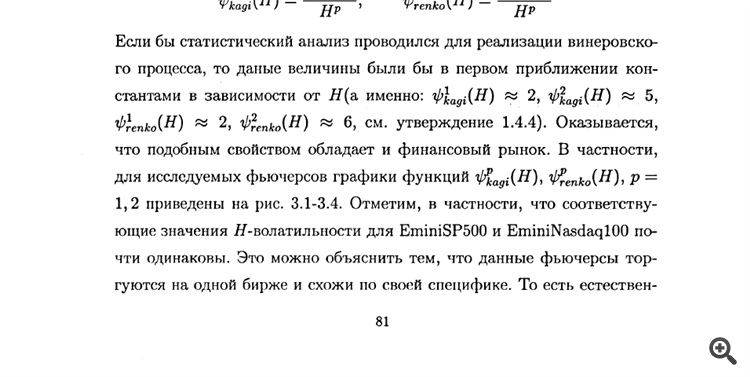- Emulation of ticks from an EA/indicator
- a trading strategy based on Elliott Wave Theory
- Why is the normal distribution not normal?
There was a thread like this here once upon a time https://www.mql5.com/ru/forum/105771
и
https://www.mql5.com/ru/forum/105771
are all about H volatility. Is anyone else interested in this?

- 2007.11.14
- www.mql5.com
The question concerns page 81. The formulas are slightly out of place, where the brackets, Kagi(H) is approximately 2, Kagi2(H) is approximately 5, Renko(H) is approximately 2 and Renko2(H) is approximately 6. It's a bit confusing with these numbers. The construction of Kagi is more sensitive than Renko, and here everything equates to a 2, and then some doubts.
Let me remind a bit the case without arbitrage market we have when constructing the zigzag Kagi and Renko H-volatility =2, flat<2, trend>2. This is the same as in the case of Hurst index.
I certainly appreciate the pursuit of knowledge, but I only have two questions
1) what the hell is this thing?
2) what is it for?
hohohohohoho((( what is this ?
I certainly appreciate the pursuit of knowledge, but I only have two questions
1) what the hell is this thing?
2) what is it for?
Well, it should be understood that the humble housewife is talking to a learned husband, not to a lunatic like you).
There is also a similar publication here https://www.argolab.net/izuchaem-zigzagi.html
This is actually the same thing, only the formula has been slightly modified and the concept of overshoot has been introduced. The principle is the same.
All the zigzags are used by threshold value, as well as in Pastukhov's thesis.
In the case of Renko zigzags, which are less sensitive than Kagi, the probability distribution of the occurrence of H-segments is in the power of two, i.e.
1H-50%, 2H-25%, 3H-12,5%, etc. Hence non-arbitrariness is obtained, i.e. on average on SB we have 2 segments On BP at rather large sample we get the same figures, i.e. we have a little more than 2 or a little less than 2.
I am interested in Kagi zigzag distribution, can someone tell me, because there is no 2.

- www.argolab.net
Example of building a Kagi zigzag
https://www.mql5.com/ru/code/1027
and this is a Renko zigzag,if(High[i]>zzH[last] add + depth ,
} else //direction<0 { if(Low[i]<zzL[last] добавить -depth
//+------------------------------------------------------------------+ //| FastZZ.mq4 | //+------------------------------------------------------------------+ #property copyright "Copyright 2012, Yurich" #property link "https://login.mql5.com/ru/users/Yurich" //--- #property indicator_chart_window #property indicator_buffers 4 #property indicator_color1 Red #property indicator_color2 Red #property indicator_color3 Gold #property indicator_color4 DodgerBlue #property indicator_width3 3 #property indicator_width4 3 //--- input parameters extern int Depth = 300; extern bool AllPoint = true; //--- double zzH[], zzL[]; double depth; int last, direction, pbars; datetime lastbar; double ArrUp[]; double ArrDn[]; //+------------------------------------------------------------------+ int init() { //---- indicators SetIndexBuffer(0,zzH); SetIndexBuffer(1,zzL); SetIndexBuffer(2,ArrUp); SetIndexBuffer(3,ArrDn); SetIndexStyle(0,DRAW_ZIGZAG); SetIndexStyle(1,DRAW_ZIGZAG); SetIndexStyle(2,DRAW_ARROW); SetIndexStyle(3,DRAW_ARROW); SetIndexArrow(2,159); SetIndexArrow(3,159); SetIndexEmptyValue(0,0.0); SetIndexEmptyValue(1,0.0); IndicatorDigits(Digits); //---- depth=Depth*Point; direction=1; last=0; pbars=0; lastbar=0; return(0); } //+------------------------------------------------------------------+ int start() { int limit=Bars-IndicatorCounted()-1; if(lastbar!=Time[0]) { lastbar=Time[0]; last++; } if(MathAbs(Bars-pbars)>1) { last=Bars-1; limit=last;} pbars=Bars; //--- for(int i=limit; i>0; i--) { bool set=false; zzL[i]=0; zzH[i]=0; ArrUp[i]=EMPTY_VALUE; ArrDn[i]=EMPTY_VALUE; //--- if(direction>0) { if(High[i]>zzH[last]+depth) { zzH[last]=0; zzH[i]=High[i]; if(AllPoint) ArrUp[i]=High[i]; if(Low[i]<High[last]-depth) { if(Open[i]<Close[i]) { zzH[last]=High[last]; ArrUp[i]=High[i]; }else direction=-1; zzL[i]=Low[i]; ArrDn[i]=Low[i]; } last=i; set=true; } if(Low[i]<zzH[last]-depth && (!set || Open[i]>Close[i])) { zzL[i]=Low[i]; ArrDn[i]=Low[i]; if(High[i]>zzL[i]+depth && Open[i]<Close[i]) { zzH[i]=High[i]; ArrUp[i]=High[i]; }else direction=-1; last=i; } } else //direction<0 { if(Low[i]<zzL[last]-depth) { zzL[last]=0; zzL[i]=Low[i]; if(AllPoint) ArrDn[i]=Low[i]; if(High[i]>Low[last]+depth) { if(Open[i]>Close[i]) { zzL[last]=Low[last]; ArrDn[i]=Low[i]; }else direction=1; zzH[i]=High[i]; ArrUp[i]=High[i]; } last=i; set=true; } if(High[i]>zzL[last]+depth && (!set || Open[i]<Close[i])) { zzH[i]=High[i]; ArrUp[i]=High[i]; if(Low[i]<zzH[i]-depth && Open[i]>Close[i]) { zzL[i]=Low[i]; ArrDn[i]=Low[i]; }else direction=1; last=i; } } } //---- zzH[0]=0; zzL[0]=0; //---- return(0); } //+------------------------------------------------------------------+

hohohohohoho((( what is that ?
This is "Woe of Wit" in the highest degree of purification. A purging of the connection to reality.
- Free trading apps
- Over 8,000 signals for copying
- Economic news for exploring financial markets
You agree to website policy and terms of use
